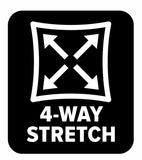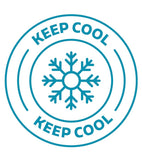The Science of Comfort: What Makes Scrubs Truly Comfortable?
Bunching, wrinkling, stretching, and twisting…you’ve all been there. Sometimes, mere months after buying lovely, new scrubs, they develop a mind of their own. Pieces that once hugged your body in all the right places now leave you adjusting, scratching, sweaty, and uncomfortable. Furthermore, a poor scrub fit leaves your undies exposed to the world and your pants dragging on a microbe-heavy floor. It’s not a good look, especially for healthcare professionals with zero time for nonsense. It would be best to have comfortable and flexible scrubs that are tough, breathable, antimicrobial, and…… wrinkle-free.
Scrub Pro understands healthcare apparel and your need for comfort features in your workwear. We’ve created this comprehensive guide to the best scrub materials and their features. We’ll break down everything you need to know about each fiber, explain which is best for each situation, and how to choose your fabric based on your body, line of work, and climate.
Most scrubs are made from the same four fabric fibers: cotton, polyester, spandex, and rayon (also called viscose). Each fiber is beneficial but often woven together to create the perfect blend for your needs.
Let’s take a look at each fiber individually.

Cotton:
Creates a lightweight and anti-static scrub
Our Cotton Pick: Carhartt
Cotton is the best choice when you need a basic, powerhouse fabric. This lightweight fabric is breathable and durable, creating scrubs that are easy to wear, keep you cool, and last over time. Its soft feel against the skin is pleasant and doesn’t build up static electricity like many other fabrics. Why does static buildup matter? Dry hospital air from so much oxygen use in the building will leave you afraid to go near even the most innocent metal door handle. If you’re hoping to avoid the frequent shocks standard in the hospital setting, cotton is for you!
Okay, we have to address the sweat. It’s inevitable. You will sweat during your shift and don’t want it hanging around and making a scene. Unfortunately, cotton fabrics tend to absorb and store moisture, generating unsightly sweat stains and leaving you with that gross, clammy feeling. (Hint: some cotton fabrics are treated to combat this, but most are blended to borrow properties from another material and create moisture-wicking scrubs.)
Cotton does well in dying and printing, holding bold colors and beautiful patterns. However, it is prone to fading after many washes. Furthermore, cotton can shrink if washed in hot water or dried on high heat, leaving you without well-fitting work clothes. Protect your soft scrub materials by soaking them in cool water and air drying them. Iron your uniforms after drying to wipe away wrinkles and sanitize them.
Polyester:
Creates a moisture-wicking and durable scrub uniform
Best polyester, moisture-wicking scrubs - Infinity

Polyester is another popular choice of scrub manufacturer, and it is typically blended with other materials. This synthetic material is resistant to wrinkles, stretching, and shrinking, making it an excellent option for those who want scrubs that are easy to care for. It’s also highly durable and will hold up even in extreme healthcare work environments.
One of polyester's most beneficial characteristics is its moisture-wicking properties. Natural fibers tend to soak up moisture and hold onto it, producing stains and allowing bacteria to grow. Synthetic fibers, such as polyester, are hydrophobic. This means that when you sweat, the fabric pulls the moisture into the garment. Then, capillary action moves it to the outermost layer and releases it through evaporation, leaving you fresh and dry.
Polyester does have its pitfalls, starting with its feel. It’s not as pleasant as others when used as a standalone fabric. Choose a polyester blend to take advantage of its positive qualities while enjoying a pleasant scrub against the skin.
Spandex:
Best fiber for stretch and comfort
Best stretchable scrubs - Healing Hands HH Works
Best stretchable scrubs - Healing Hands HH Works

With its complementary stretch, spandex has become another hot choice in scrub manufacturing. It is a synthetic, stretchy material not derived from a natural plant or animal like cotton or wool.
Spandex is unique because it fully recovers after repetitive stretching and stays soft and supple even after much wear and tear. Wearing spandex scrubs allows you the flexibility to move in any way necessary throughout your shift without readjusting your workwear. It’s a moisture-wicking fabric, similar to other synthetics, though not as effective as polyester. For this reason, many spandex materials are almost always a blend of several synthetics.
Like cotton, spandex does not build up static electricity, leaving you shock-free throughout your shift.
When caring for spandex scrubs, wash them in cold water and use the gentle cycle to prevent damage. If your machine has an agitator, using a garment bag is recommended to keep your scrubs from becoming entangled.
Rayon:
Best fiber for movement and breathability
Best rayon scrubs MedWorks Epic
Best rayon scrubs MedWorks Epic

Rayon is a semi-synthetic fiber in a class of its own. It is created using natural materials such as bamboo but processed using chemicals, making it synthetically born. Rayon’s smooth texture boosts it to the top of the list for scrub manufacturing.
Rayon is very absorbent, much like cotton, but is a breathable fabric that will dry quickly, keeping you comfortable throughout your shift. It also drapes beautifully, almost like silk, but is heavier and upholds well to use as workwear. Rayon is ideal if you work in a hot environment as it doesn’t hold heat, leaving you relaxed even during the hottest days.
Rayon tends to shrink when wet, so it’s often blended to borrow the durability of other materials; otherwise, it will require dry cleaning.
Making Your Selection:
Most scrubs are created using various blends of fibers. When choosing the right scrubs for you, consider each fiber individually. Which fibers contain properties that are most important to you? Do you need moisture-wicking scrubs that are also stretchy and comfortable? A polyester/spandex blend, like Skechers scrubs, is probably best. Do you work in an OR and need anti-static scrubs? Choose a cotton/spandex blend, such as a Fexibilitee Crew neck Long Sleeve Tee under scrub, and avoid those unpleasant shocks.
HINT: When shopping on ScrubPro.com, you can easily find each scrub’s blend by choosing a garment and scrolling down to the features list. Alternatively, you can search for an individual fiber (such as cotton) from the main search bar to view a list of scrubs featuring your preferred material.
Once you’ve identified your perfect fiber blend, consider other options and features within that brand. Which style fits you best? Do you enjoy a fun print or the professional look of a solid? Do you prefer pocket placement, or do you look for pocketless scrubs? Do you prefer scrubs with a stretchy waistband or something more fitted? Consider your most essential options and seek them out within brands that offer your preferred fiber blend.
SCRUB PRO Uniforms: Two Decades of Excellence
You need new scrubs, and Scrub Pro has them! Both online and in-store, you’ll find an unbeatable selection with fast shipping, hassle-free returns and exchanges, and unsurpassed customer service.
Please find your nearest store: Check out our locations to find the closest one.
Shop online: Can’t make it to the store? Explore our entire collection from the comfort of your home at ScrubPro.com.

Tammy McKinney, a seasoned Registered Nurse, distinguished healthcare writer, and founder of HelpfulHospiceNurse.com, is committed to using her medical knowledge to educate, inform, and entertain healthcare workers and their patients. To connect with Tammy directly, check her out on LinkedIn.




